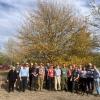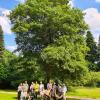Editor's Picks
Plant Focus
Walter D. Koenig
Published May 2019 in International Oaks No. 30: 45–52
Abstract
How are oaks responding to a changing world? At Hastings Reservation in central coastal California, conditions have warmed an average of 1.08 ºC over the past 80 years, primarily due to increasing temperatures at night over much of the year. These changes appear to have had no detectable effect on acorn production by any of the five species at this site. However, variability in acorn production – masting behavior – has decreased considerably since 1980, the first year for which data are available. This decrease is matched by decreased variability in annual rainfall over the same 39-year period, although over a longer, 80-year period the trend in variability of annual rainfall has been positive rather than negative. Even more dramatic effects on oak populations have been apparently due to changes in land use. In particular, canopy cover at Hastings increased from 22.2% to 42.7% between 1979 and 2013. This was primarily due to increased density of Quercus agrifolia, the main evergreen species, at the expense of the deciduous Q. lobata, a pattern that is found elsewhere in California as well. Understanding changing oak populations and protecting them in the future will require careful consideration of multiple factors, including climate change, land-use patterns, and other ecological factors such as interspecific interactions that will potentially be even more difficult to detect and interpret.
Keywords
acorn production, climate change, land-use patterns, oak communities
References
Callaway, R.M. 1992. Effect of Shrubs on Recruitment of Quercus douglasii and Quercus lobata in California. Ecology 73(6): 2118-2128.
Dolanc, C.R., H. D. Safford, S.Z. Dobrowski, and J.H. Thorne. 2014. Twentieth century shifts in abundance and composition of vegetation types of the Sierra Nevada, CA, US. Applied Vegetation Science 17(3): 442-455.
Griffin, J.R. 1971. Oak regeneration in the upper Carmel Valley, California. Ecology 52: 862-868.
James, F.C., and H.H. Shugart, Jr. 1970. A quantitative method of habitat description. Audubon Field Notes 24: 727-736.
Koenig, W.D., J.M.H. Knops, W.J. Carmen, M.T. Stanback, and R.L. Mumme. 1994a. Estimating acorn crops using visual surveys. Canadian Journal of Forest Research 24(10): 2105-2112.
Koenig, W.D., R.L. Mumme, W.J. Carmen, and M.T. Stanback. 1994b. Acorn production by oaks in central coastal California: variation within and among years. Ecology 75(1): 99-109.
Koenig, W.D., J.M.H. Knops, W.J. Carmen, M.T. Stanback, and R.L. Mumme. 1996. Acorn production by oaks in central coastal California: influence of weather at three levels. Canadian Journal of Forest Research 26: 1677-1683.
Koenig, W.D., J M.H. Knops, W.J. Carmen, and I.S. Pearse. 2015. What drives masting? The phenological synchrony hypothesis. Ecology 96(1):184-192.
McMahon, D.E., I.S. Pearse, W.D. Koenig, and E.L. Walters. 2015. Tree community shifts and Acorn Woodpecker population increases over three decades in a Californian oak woodland. Canadian Journal of Forest Research 45: 1113-20.
Muick, P.C. 1991. Effects of Shade on Blue Oak and Coast Live Oak Regeneration in California Annual Grasslands. In Proceedings of the Symposium on Oak Woodlands and Hardwood Rangeland Management; October 31 - November 2, 1990, Gen. Tech. Rep. PSW-GTR-126, coordinated by R.B. Standiford, pp. 21-24. Berkeley, CA: U.S. Department of Agriculture Forest Service, Pacific Southwest Research Station.
Pearse, I.S., W.D. Koenig, and D. Kelly. 2016. Mechanisms of mast seeding: resources, weather, cues, and selection. New Phytologist 212(3): 546-562.
Pearse, I.S., J.M. LaMontagne, and W.D. Koenig. 2017. Inter-annual variation in seed production has increased over time (1900–2014). Proceedings of the Royal Society of London, Series B 284: 20171666.
R Core Team. 2016. R: a language and environment for statistical computing. R Foundation for Statistical Computing, Vienna, Austria. www.R-project.org.
Stromberg, M.R. 2017. Frances Simes Hastings Natural HIstory Reservation: The History of a Biological Field Station in Carmel Valley. CreateSpace Independent Publishing Platform.
Tyler, C.M., B. Kuhn, and F.W. Davis. 2006. Demography and recruitment limitations of three oak species in California. Quarterly Review of Biology 81(2): 127–152.
Walther, G.-R., E. Post, P. Convey, A. Menzel, C. Parmesan, T.J.C. Beebee, J.-M. Fromentin, O. Hoegh-Guldberg, and F. Bairlein. 2002. Ecological responses to recent climate change. Nature 416: 389-395.
White, K.L. 1966. Structure and composition of foothill woodland in central coastal California. Ecology 47(2): 229-237.















